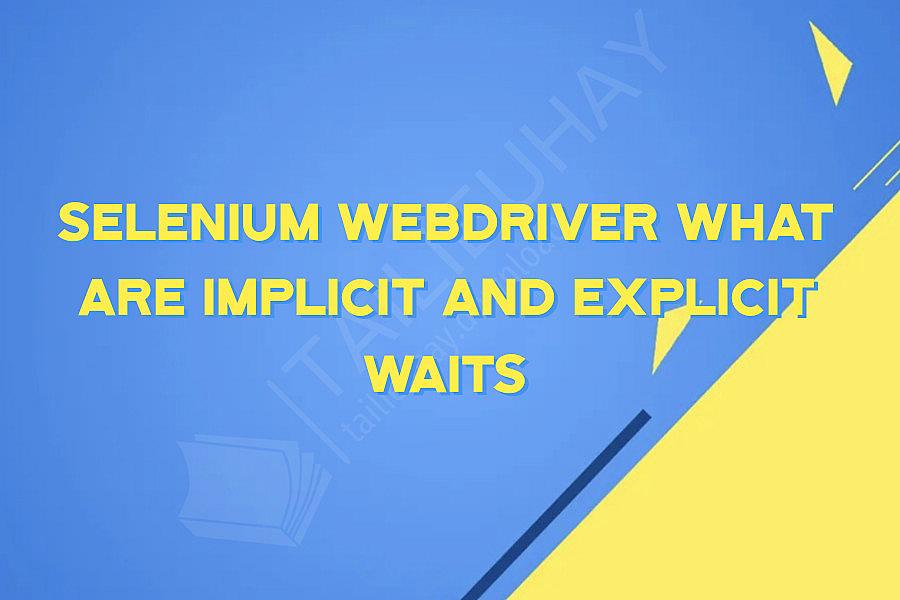Selenium Webdriver What are Implicit and Explicit Waits

Selenium Webdriver is an open-source automation tool that is widely used for web application testing. This tool provides a simple and efficient way to test web applications by automating user interactions and performing various tasks such as filling out forms, clicking on buttons, and navigating through different pages. One of the most important features of Selenium Webdriver is the ability to use implicit and explicit waits.
Implicit waits
Implicit waits are a type of wait in Selenium Webdriver that allow a test to wait for a certain amount of time for an element to be found or for an action to be performed. Implicit waits tell the WebDriver to wait for a certain amount of time before throwing an exception. This type of wait is useful when waiting for a page to load or when waiting for an element to appear on the page.
The command for implicit waits is simple and straightforward:
driver.manage().timeouts().implicitlyWait(10, TimeUnit.SECONDS);
Here, the implicit wait is set to 10 seconds. This means that the WebDriver will wait for a maximum of 10 seconds before throwing a NoSuchElementException or a TimeoutException.
Explicit waits
Explicit waits are another type of wait in Selenium Webdriver that allow a test to wait for a specific condition to occur before continuing with the test. This type of wait is very useful when waiting for dynamic elements to load on the page. For example, a web page may have a loading spinner that disappears after the page finishes loading.
The command for explicit waits is more complex than implicit waits:
WebDriverWait wait = new WebDriverWait(driver, 10);
WebElement element = wait.until(ExpectedConditions.visibilityOfElementLocated(By.id("elementId")));
Here, the explicit wait is set to 10 seconds. The WebDriverWait constructor takes two arguments: the WebDriver instance and the amount of time to wait for a condition to occur. The WebDriverWait then waits for a specific condition to occur before continuing with the test. In this example, the condition is the visibility of an element located by its ID.
In conclusion, both implicit and explicit waits are important tools that can be used to wait for certain conditions to occur before continuing with a test. Implicit waits are ideal for waiting a certain amount of time for a page to load or for an element to appear on a page, whereas explicit waits are useful for waiting for specific conditions to occur. Both types of waits have their own benefits and limitations, so it is important to choose the right type of wait for each situation.
Implicit waits
Implicit waits are a type of wait in Selenium Webdriver that allow a test to wait for a certain amount of time for an element to be found or for an action to be performed. Implicit waits tell the WebDriver to wait for a certain amount of time before throwing an exception. This type of wait is useful when waiting for a page to load or when waiting for an element to appear on the page.
The command for implicit waits is simple and straightforward:
driver.manage().timeouts().implicitlyWait(10, TimeUnit.SECONDS);
Here, the implicit wait is set to 10 seconds. This means that the WebDriver will wait for a maximum of 10 seconds before throwing a NoSuchElementException or a TimeoutException.
Explicit waits
Explicit waits are another type of wait in Selenium Webdriver that allow a test to wait for a specific condition to occur before continuing with the test. This type of wait is very useful when waiting for dynamic elements to load on the page. For example, a web page may have a loading spinner that disappears after the page finishes loading.
The command for explicit waits is more complex than implicit waits:
WebDriverWait wait = new WebDriverWait(driver, 10);
WebElement element = wait.until(ExpectedConditions.visibilityOfElementLocated(By.id("elementId")));
Here, the explicit wait is set to 10 seconds. The WebDriverWait constructor takes two arguments: the WebDriver instance and the amount of time to wait for a condition to occur. The WebDriverWait then waits for a specific condition to occur before continuing with the test. In this example, the condition is the visibility of an element located by its ID.
In conclusion, both implicit and explicit waits are important tools that can be used to wait for certain conditions to occur before continuing with a test. Implicit waits are ideal for waiting a certain amount of time for a page to load or for an element to appear on a page, whereas explicit waits are useful for waiting for specific conditions to occur. Both types of waits have their own benefits and limitations, so it is important to choose the right type of wait for each situation.
Khóa Học Cùng Chủ Đề
After Effects Essentials
Build a Recommendation Engine
Complete ASP.NET Core 0 MVC Single-Page App[The FUTURE]
Complete Blockchain, Cryptocurrency, Wallet Development
Complete Ruby on Rails Single-Page App [The FUTURE]
Getting Started with Maya 2017
Musketeers App online roulette numbers forecasting App
Premiere Pro 101
SQUATS FROM A TO Z
The Maxx You Project How To Capture an Authentic You
12 Small Programs in Java
3ds max making of subway train
7 Scientifically Proven Steps to Increase Your Influence
Adobe Flash CS5 for Beginners
Adsense Masterclass 2018